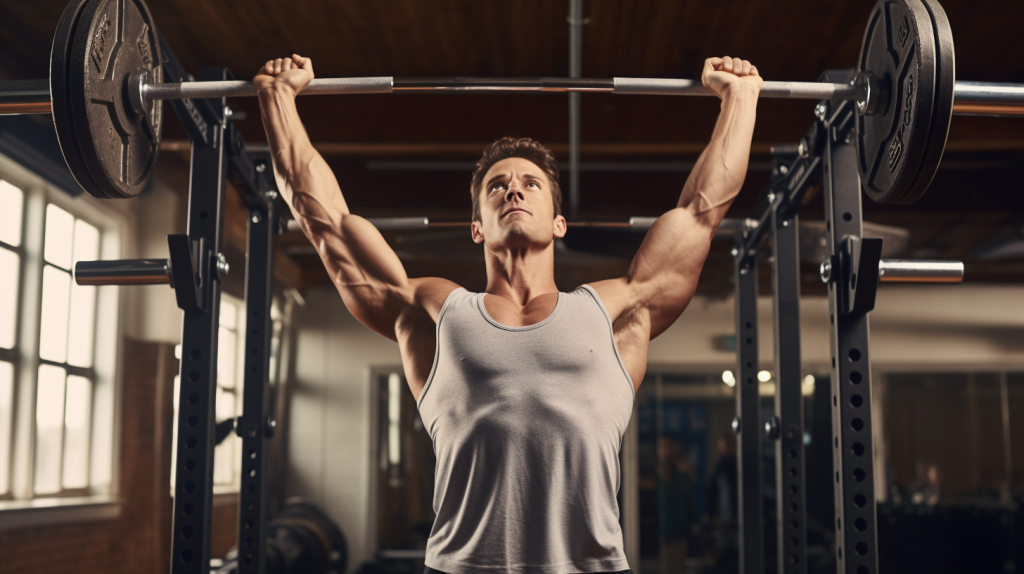Geschatte leestijd: 3 minuten
The shoulder press is a shoulder exercise that can be performed in multiple ways, both standing and sitting. But you also have the option to perform the exercise with dumbbells or a barbell. In this article, we answer the question: “What is the ‘best’ way to do the shoulder press?”
The shoulder dumbbell press
Norwegian researchers measured the differences in load on the shoulder muscles between: performing the shoulder press with a barbell or with dumbbells and in the
standing or
sitting position.
They had 15 healthy men perform shoulder presses in different ways and measured the tension on various parts of the deltoid, biceps, and triceps using EMG (Electromyography). EMG can be measured using various methods. In this case, a needle investigation was done where the activity of a muscle is measured with a fine needle. Additionally, they looked at how the most strength could be developed (1-RM, the maximum weight with which you can perform one repetition). The EMG measurements were performed on repetitions executed at 80% of 1-RM.
The results and conclusion of the research
The researchers conclude that the greatest neuromuscular activity (the greatest muscle tension) on the shoulder muscles is caused by exercises that require greater stability (standing instead of sitting and dumbbells instead of barbell), although this also results in the lowest 1-RM.
The conclusion explained
Nothing new under the sun, many will say. Most people will know from experience that you can often lift more weight with seated exercises.
Many will also understand the correlation that the harder an exercise becomes due to adjustments in execution (and therefore the 1-RM decreases), the more this engages the selected muscles. This is mainly due to the elimination of synergists, assisting muscles.
It is a pity that the researchers did not look at the load on the upper chest muscles. In my opinion, this explains a large part of the differences between seated and standing shoulder presses. This is mainly due to the angle of the torso. Try doing shoulder presses on a
fitness bench without a backrest. You will notice that this is about as heavy as standing.
With a backrest, you can lean slightly backward, causing your upper chest muscles to be more engaged (similar to
incline bench presses) and thus assisting in the movement. Without support or standing, you must keep your back straight because otherwise, you will fall over. Because the upper chest muscles help less and the shoulders are isolated, the movement becomes heavier. Therefore, I always set my bench completely upright during a seated shoulder press to minimize chest involvement. Most people set it slightly inclined, consciously or unconsciously, to be able to press more weight. It is not clear how straight the bench was in the study.
The height of 1-RM is much less important for a bodybuilder than the load on the muscle. As a weightlifter, the opposite applies, and you try to lift as much as possible with as little effort as possible through technique. For bodybuilding, the goal is to load the muscle as heavily as possible. Since heavy weights pose more risk of injury, it is often advisable to do difficult executions or more difficult exercises instead of continually adding more plates.
What does this say about your shoulder training?
If you are doing it right, you are already providing enough variation in your training to keep your muscles stimulated. Even if there were such a thing as “the best exercise,” it makes no sense to only do this exercise. After following a schedule for a few weeks, it is wise to do a few weeks of different exercises to keep your muscles stimulated. Always doing the same exercise yields less and less despite the increasingly heavier weights you can lift (law of diminishing returns). Your ego grows faster than your muscles.
Even if you know this, you may still have certain favorite exercises that you do relatively often. If you then choose to do an exercise relatively often, it is useful to know which exercise engages the muscles better. This could mean, for example, that you do the shoulder press more often with dumbbells than with a barbell or standing instead of (inclined) sitting.
Source
- Saeterbakken A.H., Fimland M.S. Effects of body composition and loading modality on muscle activity and strength in shoulder presses. National Strength and Conditioning Association. Published Ahead-of-Print

